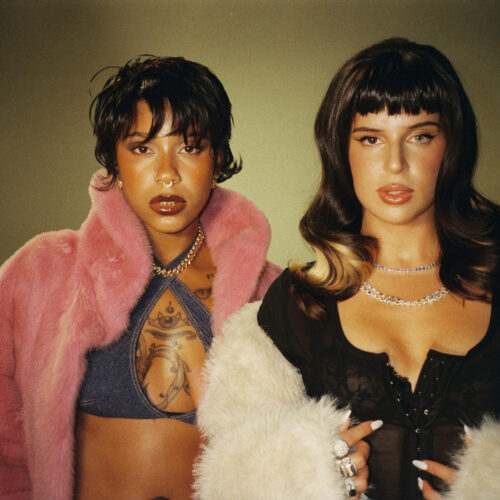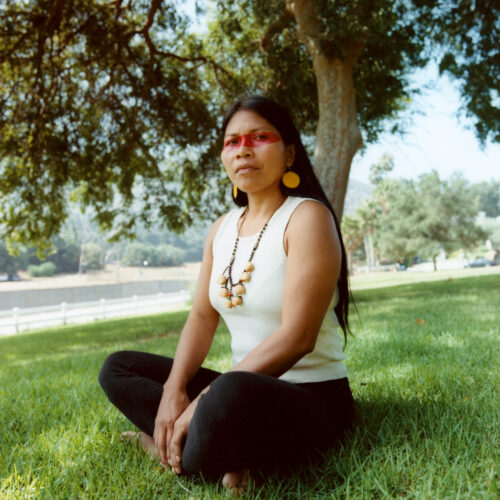Reinvention defined Rebecca Black Was Here, the 2021 EP by Mexican-American pop star Rebecca Black. No longer was she the 13-year-old mocked for “Friday;” rising from the ashes of social media ridicule as she asserted herself as an artist. After this public reappraisal, the completion of her so-called redemption arc, people who listened to her bittersweet yet danceable ballads could no longer write her off as a dead meme searching to relive its fleeting moment in the limelight.
With her newest album release Let Her Burn, Black moves beyond a narrative of redefinition and redemption. Divorced from “Friday,” she approaches her music with great maturity, unsurprising for the now 25-year-old. Reflecting on the album’s lead single, “Crumbs,” Black told LATINA, “[Crumbs] was a touchier subject than I’d ever gotten into before. It’s a song about sexuality and sensuality, and, you know, finding your own place within a relationship with somebody.” She added that the song is ultimately about “internal discovery” and poses the questions, ‘Where do you feel comfortable with your sensuality? Where does your dominance live? Where does your submissiveness live?’” Heartbreak weaves through Let Her Burn but on “Crumbs,” love is brutally distorted. Light-hearted intimacy is replaced by a gripping, unconditional infatuation that casts an addictive, self-destructive spell.
The metaphorically dense and visually dark music video for “Crumbs” is a far cry from Black’s previous internet-entrenched work. Instead of sharing a convertible with a troupe of troll faces or satirically acting as a bimbo with a glimmering tiara and “muppet-like” breasts, in “Crumbs,” Black is caressed by anonymous gloved hands and finds herself tied up. However, Black has not divorced herself from levity. After all, she is a pop star. Indebted to hyperpop, this ironic and abrasive re-appropriation of the supposedly vapid, garish, saccharine, and overly autotuned electronic music of the late aughts, Black sees herself pushing her sound forward into a more emotionally honest place. Even as Black performs as a leather-clad surgeon with glistening glass nails, turning the medical theater into a runway, the surgery itself is an operation on her own body. Introspection and emotional vulnerability exist alongside Black’s impossible glamor. Even when she performs, she probes deep.

Sarah Pardini
This sense of honesty, this unveiled self-assertion, is central to the sound of Let Her Burn. Although Black taps into many aesthetics, sourcing from everywhere, whether New Jack Swing, Industrial Rock, or 2-Step, the album is coherent in vision. Each sound, however disparate, is wrapped up in her dark, maximalist, world. Black describes her sound as “fully fleshed out” and “in this drama-based world,” and listeners may find themselves wrapped up in her ornate sonic universe, whether it be the underbelly of murky bass lines or the open expanses of nearly orchestral synth-lines. Throughout, there is a sense of otherworldliness. Black melts in and locates herself within each track, each of which took months of meticulous experimentation and revision. She is never awkwardly placed, lost singing atop a drum-and-bass break like a knock-off Pink Pantheress; instead, Black adds a crunchy, heavy metal lick, chanting, “Go ahead destroy me, destroy me,” the song exploding under this angsty yet danceable catharsis, where the listener can only violently purge and let loose. On Let Her Burn, Black is always at home, present as herself.
In her experience, Black has found that her identity as a Latina artist can set her up for certain expectations and limitations. She explained “when the industry finds out you’re Mexican, they’re like, ‘Where’s the Hispanic music? Where’s the reggaeton? Let’s make the song in Spanish.’” Although she has collaborated with Latino artists and worked on bilingual tracks, Black does not relate to her heritage in the same way other Latin artists do. She did not grow up speaking fluent Spanish, and does not want to capitalize on that element of her identity.
To do so, for Black, would be to “caricature herself,” an action she views as disempowering to the Latino community, one which pigeonholes and, in her case, leads to an inauthentic expression of herself. For Black, the question is not how she can transform herself into the perfectly marketable Latina but “how, being a Mexican artist, can I understand myself and what it means to be myself?” Black, in her words, wants to make a name for Mexican heritage in all kinds of music; she compares her foray into electropop with Omar Apollo’s self-discovery through indie pop.
Black’s queer identity, too, has been a place of self-discovery. Even though she only recently came out as queer, Black has found herself feeling like an unworthy representative of the community. She approaches her queerness with humility, wanting to use her platform for good, but “not trying to speak for the entire community.” Black has worked silently with groups such as GLAAD, fighting for inclusive LGBTQ+ representation in media. She takes a quiet approach with her advocacy work, which seems to be at odds with her persona, that is, her ethereal, charismatic power on-stage. But off-stage she burns differently, her presence is warm: Black embodies kindness.
Rebecca Black will be on tour throughout North America from May 4th to May 20th, performing in Brooklyn, Los Angeles, and Chicago, among other cities. Tickets can be found here.









